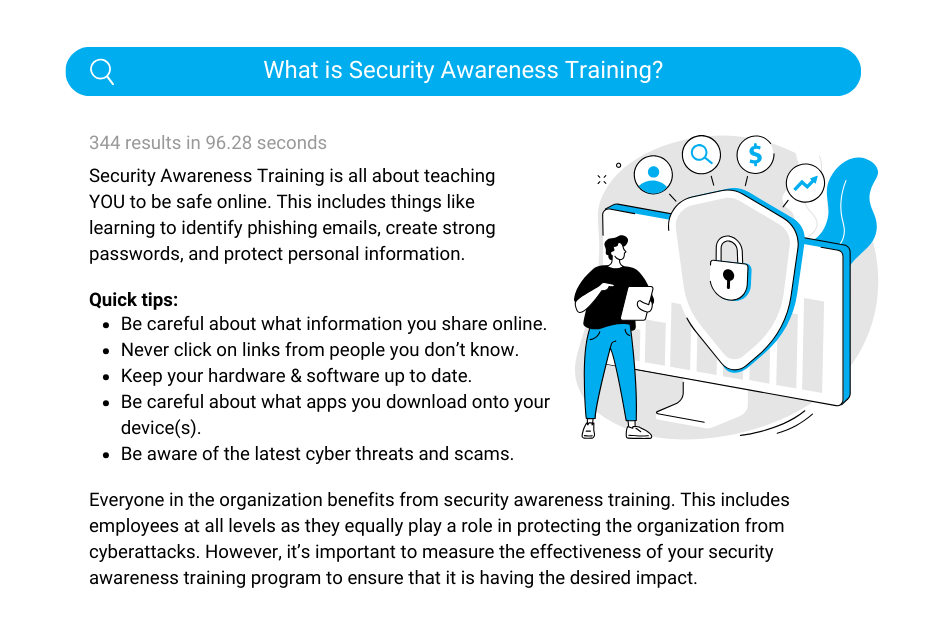
Utilizing security awareness training in your organization is important on many different fronts. As much as anyone hates to admit it, the weakest security link in any organization is the employees. More specifically, untrained employees. All it takes is for one employee to drop their credentials into a phishing email link and bam! Bad actors have access to your network.
Implementing security awareness training is absolutely essential for two main reasons:
reasons:
1. It helps to protect the organization from cyberattacks.
2. It fosters a culture of security within the organization.
Cybercriminals are always finding innovative ways to target organizations. That's why it's crucial for employees to be the first line of defense. Through security awareness training, employees can stay updated on the latest threats and learn how to safeguard themselves and the organization from potential attacks.
Who benefits from security awareness training?
Everyone in the organization benefits from security awareness training. This includes employees at all levels, from the CEO to the receptionist. Data security is critical, and everyone plays a role in protecting the organization from cyberattacks, and security awareness training can help everyone to do their part. However, it's important to measure and track the effectiveness of your security awareness training program to ensure that it is having the desired impact.
Here are six ways to measure security awareness training and education:
Pre- and post-training assessments
Conducting pre- and post-training assessments is a highly effective method to gauge the effectiveness of your security awareness training program. These assessments allow you to track the knowledge and awareness that employees have gained throughout the training process.
Phishing simulations
Conducting phishing simulations is an effective method to assess employees' proficiency in recognizing and reporting phishing emails. This skill is crucial because phishing attacks are frequently used by cybercriminals to infiltrate organizations.
Security incident reporting rates
Monitoring the frequency of security incidents reported can serve as a valuable indicator of the effectiveness of your security awareness training program. A noticeable decline in the number of reported incidents following the implementation of the training signifies a positive impact and demonstrates that the program is indeed making a difference.
Employee surveys
Another effective method to gather feedback on your security awareness training program is through employee surveys. By asking employees about their level of satisfaction with the program, what they have learned, and how they are implementing the knowledge in their daily work, you can gain valuable insights into the effectiveness of the training. Employee surveys provide a platform for employees to share their thoughts and experiences, allowing you to further improve and tailor the security awareness training program to meet their needs.
Security audits
Conducting security audits is a valuable tool to evaluate the overall success of your security awareness program. This encompasses various aspects such as the caliber of training materials, the effectiveness of the training delivery, and the level of employee engagement. By conducting security audits, organizations can gain valuable insights into the strengths and weaknesses of their security awareness program, allowing them to make necessary improvements and enhance the overall security culture within the organization.
Creating accountability for training
Once you have measured the effectiveness of your security awareness training program, you need to create accountability for training. This means making sure that employees are required to complete the training and that they are held accountable for the information that they learn.
Here are some tips for creating accountability for training:
- Make training mandatory so that all employees should be required to complete security awareness training.
- Track which employees have completed the training and which ones have not.
- Require employees to pass a test once they have completed the training.
In addition to creating accountability for training, it is also important to encourage participation.
Here are some tips for encouraging participation:
- Keep the training short and to the point.
- Use a variety of training methods such as simulations, games, and videos, to keep employees engaged.
- Make the training relevant to employees' and their job roles.
- Involve management to model good security behavior.

As with any security solution, follow-up testing and remediation are essential components of efficacy.
Follow-up testing is used to measure the effectiveness of the training and identify areas where employees may need additional support. This can be done through phishing simulations, quizzes, or other assessments.
Remediation is the process of providing employees with additional training or resources to help them improve their security knowledge and skills. This may be necessary for employees who struggle with certain concepts or who have performed poorly on follow-up tests.
There are a number of reasons why follow-up testing and remediation are important:
- Security awareness training is not a one-time event. Employees need to be reminded of security best practices on a regular basis. Follow-up testing can help to identify areas where employees need additional support, and remediation can provide them with the resources they need to improve their security knowledge and skills.
- Security threats are constantly evolving. Cybercriminals are always developing new ways to attack organizations, so it is important for employees to be aware of the latest threats. Follow-up testing can help to ensure that employees are up-to-date on the latest security threats and know how to protect themselves.
- Security awareness training can help to reduce the risk of cyberattacks. However, it is important to note that no security training program is perfect. Employees may still make mistakes, even if they have been trained on the latest security best practices. Follow-up testing and remediation can help to reduce the risk of these mistakes leading to successful cyberattacks.
Here are some examples of how follow-up testing and remediation can help organizations protect themselves against cyberattacks:
- An employee who fails a phishing simulation may be required to complete additional training on how to identify phishing emails. This can help to prevent the employee from falling victim to a phishing attack in the future.
- An employee who struggles with password security may be provided with a password manager tool or additional training on how to create strong passwords. This can help to improve the employee's password hygiene and reduce the risk of their account being compromised.
- An employee who is unaware of a new security threat may be provided with training on how to protect themselves from that threat. This can help to reduce the risk of the employee falling victim to that threat in the future.
Incorporating follow-up testing and remediation into your security awareness training program is crucial. By actively engaging with employees and offering additional support as necessary, organizations can effectively mitigate the risk of cyberattacks. This proactive approach empowers employees to stay vigilant and protects the organization from potential threats posed by cybercriminals.
If you're looking for a best-in-class managed security awareness training solution for your organization, book a meeting with our team using the button below!

.png)


